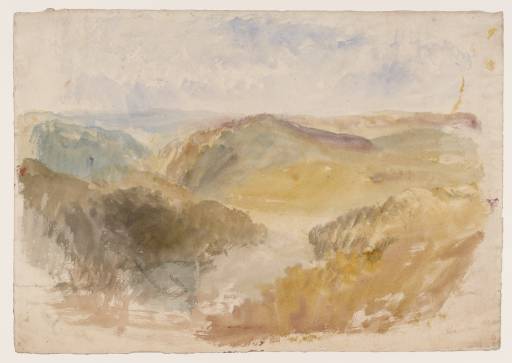Joseph Mallord William Turner The Mill Pool, Dartmouth, Devonshire c.1828-30
Joseph Mallord William Turner,
The Mill Pool, Dartmouth, Devonshire
c.1828-30
Joseph Mallord William Turner 1775–1851
The Mill Pool, Dartmouth, Devonshire c.1828–30
D25162
Turner Bequest CCLXIII 40
Turner Bequest CCLXIII 40
Watercolour on white wove paper, 341 x 483 mm
Inscribed in red ink ‘40’ bottom right
Blind-stamped with Turner Bequest monogram towards bottom right
Stamped in black ‘CCLXIII – 40’ bottom right
Inscribed in red ink ‘40’ bottom right
Blind-stamped with Turner Bequest monogram towards bottom right
Stamped in black ‘CCLXIII – 40’ bottom right
Accepted by the nation as part of the Turner Bequest 1856
Exhibition history
1935
Drawings and Sketches by J.M.W. Turner, National Museum of Wales, Cardiff, December 1935–April 1936 (45, as ‘River scene with hills’).
1997
Turner’s Watercolour Explorations 1810–1842, Tate Gallery, London, February–June 1997, Southampton City Art Gallery, June–September 1997 (63, reproduced in colour, as ‘The Mill Pool, Dartmouth, Devonshire’, ?late 1820s).
References
1909
A.J. Finberg, A Complete Inventory of the Drawings of the Turner Bequest, London 1909, vol.II, p.817, CCLXIII 40, as ‘River among mountains. Probably Yorkshire’. c.1820–30.
1997
David Hill, ‘Turner’s “Colour Beginnings” in Britain’, Turner Society News, no.76, August 1997, p.7.
1997
Eric Shanes, Turner’s Watercolour Explorations 1810–1842, exhibition catalogue, Tate Gallery, London 1997, pp.12, 27, 75 no.63, reproduced in colour, as ‘The Mill Pool, Dartmouth, Devonshire’. ?late 1820s, p.94 Appendix I under ‘Devonshire’, as ‘The Mill Pool, Dartmouth, Devonshire’. ?late 1820s, p.95 under ‘England and Wales Series’, as ‘Sketch for a view of The Mill Pool, Dartmouth, Devonshire’. ?late 1820s, p.104 Appendix II, as ‘Sketch: Mill Pool, Dartmouth’.
Eric Shanes has identified this colour study as a view of Dartmouth, Devon, from the west, looking to the Dart down the Ford Valley, as a possible undeveloped subject for Turner’s Picturesque Views in England and Wales.1 The valley was at that time a tidal inlet but has since been reclaimed and built over, while the hill on the left here is the site of the later Britannia Royal Naval College; the source appears to be an 1814 pencil sketch in the Devon Rivers, No.2 sketchbook (Tate D09730; Turner Bequest CXXXIII 50), which corresponds in the main points of topography, although the tower of St Saviour’s Church to the lower right of the sketch is omitted from the generalised treatment here.2 The viewpoint, today obstructed by trees and later development, appears to be around the top of Mount Boone.
Turner had also visited Dartmouth in 1811 on his first tour of the West Country, and in about 1814 he made the watercolour Dartmouth, Devon (currently untraced),3 engraved in 1815 for the Picturesque Views on the Southern Coast of England (Tate impressions: T04381, T04382, T05390, T05391, T05969). Two further watercolours followed in 1822 for the Rivers of England: Dartmouth Castle, on the River Dart (Tate D18137; CCVIII D),4 engraved in 1824 (Tate impressions: T04802–T04804) and Dartmouth, on the River Dart (Tate D18136; Turner Bequest CCVIII C),5 engraved in 1825 (Tate impression: T04808).
A watercolour of Dartmouth Cove of about 1826 (The Morgan Library & Museum, New York)6 had been engraved for England and Wales in 1827 (Tate impressions: T04507, T04508); Shanes has identified a second colour study (Tate D25184; Turner Bequest CCLXIII 62), watermarked 1828, as a nearby Dartmouth view, and tentatively suggests a third (Tate D25128; Turner Bequest CCLXIII 6). His dating of the present work, ‘late 1820s?’,7 partly by association with the 1828 watermark of D25184, has been rendered here as c.1828–30, postdating the engraved England and Wales Dartmouth view and perhaps suggesting that Turner had a companion piece in mind here. David Hill has described the status of Shanes’s identification as ‘not proven or positively dubious’,8 although the correspondences between it and the pencil sketch noted above seem more than fortuitous.
See also the introductions to the present subsection of identified but unrealised subjects and the overall England and Wales ‘colour beginnings’ grouping to which this work has been assigned.
Verso:
Blank, save for inscriptions: inscribed in pencil ‘AB 92 P’ top left, upside down; stamped in black with Turner Bequest monogram above ‘CCLXIII 40’ bottom left; and in pencil ‘CCLXIII 40’ bottom right.
Blank, save for inscriptions: inscribed in pencil ‘AB 92 P’ top left, upside down; stamped in black with Turner Bequest monogram above ‘CCLXIII 40’ bottom left; and in pencil ‘CCLXIII 40’ bottom right.
The ‘AB’ number corresponds with the endorsement on one of the parcels of works sorted by John Ruskin during his survey of the Turner Bequest, in this case classified by him as ‘Colour effects. Valueless’.1
There are also extensive pencil financial calculations in pounds and shillings by Turner, as set out below.
Towards centre right:
5 5 -
5 5 [?Wages]
5 5
15
5 5 [?Wages]
5 5
15
Right of centre:
30
35
20
85
35
20
85
Below right of centre right:
6 16 6 222 4
3 3 150
3 13 [...] 1825 72
12 – 10
84 . 10
3 3 150
3 13 [...] 1825 72
12 – 10
84 . 10
Towards bottom centre, where the first ‘14’ overwrites (or is possibly overwritten by) ‘20’:
14 14
19
Bottom left:
275 10 24 14 14
55 20 20
230 10 280 280 10 – 14
11 14 10 4
222 4 290 4
[...]
55 20 20
230 10 280 280 10 – 14
222 4 290 4
[...]
Bottom centre:
275 10
14 14
290 – 4
14 14
290 – 4
Lastly, bottom right:
40 50 3
10 40
5 54
15
[...] 14 14 [...]
10 2 10
10 40
5 54
15
[...] 14 14 [...]
10 2 10
Matthew Imms
March 2013
How to cite
Matthew Imms, ‘The Mill Pool, Dartmouth, Devonshire c.1828–30 by Joseph Mallord William Turner’, catalogue entry, March 2013, in David Blayney Brown (ed.), J.M.W. Turner: Sketchbooks, Drawings and Watercolours, Tate Research Publication, December 2013, https://www

